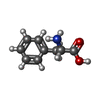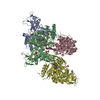+ Open data
Open data
- Basic information
Basic information
| Entry | Database: EMDB / ID: EMD-11113 | |||||||||
|---|---|---|---|---|---|---|---|---|---|---|
| Title | stimulatory human GTP cyclohydrolase I - GFRP complex | |||||||||
 Map data Map data | ||||||||||
 Sample Sample |
| |||||||||
 Keywords Keywords | GTP cyclohydrolase GFTP / I / EC:3.5.4.16 / Tetrahydrobiopterin (BH4) synthesis / Cytosol / Zinc Ion Binding / Hydrolase Activity / Metal Ion Binding / Nucleotide Binding / allosteric enzyme / substrate analogue bound / HYDROLASE | |||||||||
| Function / homology |  Function and homology information Function and homology informationGTP cyclohydrolase binding / pteridine-containing compound biosynthetic process / dihydrobiopterin metabolic process / regulation of lung blood pressure / GTP cyclohydrolase I / GTP cyclohydrolase I activity / neuromuscular process controlling posture / negative regulation of biosynthetic process / GTP-dependent protein binding / regulation of removal of superoxide radicals ...GTP cyclohydrolase binding / pteridine-containing compound biosynthetic process / dihydrobiopterin metabolic process / regulation of lung blood pressure / GTP cyclohydrolase I / GTP cyclohydrolase I activity / neuromuscular process controlling posture / negative regulation of biosynthetic process / GTP-dependent protein binding / regulation of removal of superoxide radicals / tetrahydrobiopterin biosynthetic process / neuron projection terminus / regulation of nitric oxide biosynthetic process / mitogen-activated protein kinase binding / dopamine biosynthetic process / negative regulation of cardiac muscle cell apoptotic process / positive regulation of heart rate / response to pain / response to type II interferon / negative regulation of cellular senescence / response to tumor necrosis factor / Tetrahydrobiopterin (BH4) synthesis, recycling, salvage and regulation / tetrahydrofolate biosynthetic process / positive regulation of telomere maintenance via telomerase / nitric oxide biosynthetic process / negative regulation of blood pressure / positive regulation of nitric-oxide synthase activity / regulation of blood pressure / vasodilation / positive regulation of neuron apoptotic process / melanosome / cytoplasmic vesicle / protein-containing complex assembly / nuclear membrane / response to lipopolysaccharide / GTPase activity / dendrite / calcium ion binding / protein-containing complex binding / GTP binding / protein homodimerization activity / protein-containing complex / mitochondrion / zinc ion binding / nucleoplasm / identical protein binding / nucleus / cytosol / cytoplasm Similarity search - Function | |||||||||
| Biological species |  Homo sapiens (human) Homo sapiens (human) | |||||||||
| Method | single particle reconstruction / cryo EM / Resolution: 3.0 Å | |||||||||
 Authors Authors | Ebenhoch R / Nar H | |||||||||
 Citation Citation |  Journal: Proc Natl Acad Sci U S A / Year: 2020 Journal: Proc Natl Acad Sci U S A / Year: 2020Title: A hybrid approach reveals the allosteric regulation of GTP cyclohydrolase I. Authors: Rebecca Ebenhoch / Simone Prinz / Susann Kaltwasser / Deryck J Mills / Robert Meinecke / Martin Rübbelke / Dirk Reinert / Margit Bauer / Lisa Weixler / Markus Zeeb / Janet Vonck / Herbert Nar /  Abstract: Guanosine triphosphate (GTP) cyclohydrolase I (GCH1) catalyzes the conversion of GTP to dihydroneopterin triphosphate (H2NTP), the initiating step in the biosynthesis of tetrahydrobiopterin (BH4). ...Guanosine triphosphate (GTP) cyclohydrolase I (GCH1) catalyzes the conversion of GTP to dihydroneopterin triphosphate (H2NTP), the initiating step in the biosynthesis of tetrahydrobiopterin (BH4). Besides other roles, BH4 functions as cofactor in neurotransmitter biosynthesis. The BH4 biosynthetic pathway and GCH1 have been identified as promising targets to treat pain disorders in patients. The function of mammalian GCH1s is regulated by a metabolic sensing mechanism involving a regulator protein, GCH1 feedback regulatory protein (GFRP). GFRP binds to GCH1 to form inhibited or activated complexes dependent on availability of cofactor ligands, BH4 and phenylalanine, respectively. We determined high-resolution structures of human GCH1-GFRP complexes by cryoelectron microscopy (cryo-EM). Cryo-EM revealed structural flexibility of specific and relevant surface lining loops, which previously was not detected by X-ray crystallography due to crystal packing effects. Further, we studied allosteric regulation of isolated GCH1 by X-ray crystallography. Using the combined structural information, we are able to obtain a comprehensive picture of the mechanism of allosteric regulation. Local rearrangements in the allosteric pocket upon BH4 binding result in drastic changes in the quaternary structure of the enzyme, leading to a more compact, tense form of the inhibited protein, and translocate to the active site, leading to an open, more flexible structure of its surroundings. Inhibition of the enzymatic activity is not a result of hindrance of substrate binding, but rather a consequence of accelerated substrate binding kinetics as shown by saturation transfer difference NMR (STD-NMR) and site-directed mutagenesis. We propose a dissociation rate controlled mechanism of allosteric, noncompetitive inhibition. | |||||||||
| History |
|
- Structure visualization
Structure visualization
| Movie |
 Movie viewer Movie viewer |
|---|---|
| Structure viewer | EM map:  SurfView SurfView Molmil Molmil Jmol/JSmol Jmol/JSmol |
| Supplemental images |
- Downloads & links
Downloads & links
-EMDB archive
| Map data |  emd_11113.map.gz emd_11113.map.gz | 5.7 MB |  EMDB map data format EMDB map data format | |
|---|---|---|---|---|
| Header (meta data) |  emd-11113-v30.xml emd-11113-v30.xml emd-11113.xml emd-11113.xml | 15.8 KB 15.8 KB | Display Display |  EMDB header EMDB header |
| Images |  emd_11113.png emd_11113.png | 131.5 KB | ||
| Filedesc metadata |  emd-11113.cif.gz emd-11113.cif.gz | 6.1 KB | ||
| Archive directory |  http://ftp.pdbj.org/pub/emdb/structures/EMD-11113 http://ftp.pdbj.org/pub/emdb/structures/EMD-11113 ftp://ftp.pdbj.org/pub/emdb/structures/EMD-11113 ftp://ftp.pdbj.org/pub/emdb/structures/EMD-11113 | HTTPS FTP |
-Validation report
| Summary document |  emd_11113_validation.pdf.gz emd_11113_validation.pdf.gz | 401.9 KB | Display |  EMDB validaton report EMDB validaton report |
|---|---|---|---|---|
| Full document |  emd_11113_full_validation.pdf.gz emd_11113_full_validation.pdf.gz | 401.5 KB | Display | |
| Data in XML |  emd_11113_validation.xml.gz emd_11113_validation.xml.gz | 6.1 KB | Display | |
| Data in CIF |  emd_11113_validation.cif.gz emd_11113_validation.cif.gz | 6.9 KB | Display | |
| Arichive directory |  https://ftp.pdbj.org/pub/emdb/validation_reports/EMD-11113 https://ftp.pdbj.org/pub/emdb/validation_reports/EMD-11113 ftp://ftp.pdbj.org/pub/emdb/validation_reports/EMD-11113 ftp://ftp.pdbj.org/pub/emdb/validation_reports/EMD-11113 | HTTPS FTP |
-Related structure data
| Related structure data |  6z80MC  6z85C  6z86C  6z87C  6z88C  6z89C  7accC  7al9C  7alaC  7albC  7alcC M: atomic model generated by this map C: citing same article ( |
|---|---|
| Similar structure data |
- Links
Links
| EMDB pages |  EMDB (EBI/PDBe) / EMDB (EBI/PDBe) /  EMDataResource EMDataResource |
|---|---|
| Related items in Molecule of the Month |
- Map
Map
| File |  Download / File: emd_11113.map.gz / Format: CCP4 / Size: 52.7 MB / Type: IMAGE STORED AS FLOATING POINT NUMBER (4 BYTES) Download / File: emd_11113.map.gz / Format: CCP4 / Size: 52.7 MB / Type: IMAGE STORED AS FLOATING POINT NUMBER (4 BYTES) | ||||||||||||||||||||||||||||||||||||||||||||||||||||||||||||||||||||
|---|---|---|---|---|---|---|---|---|---|---|---|---|---|---|---|---|---|---|---|---|---|---|---|---|---|---|---|---|---|---|---|---|---|---|---|---|---|---|---|---|---|---|---|---|---|---|---|---|---|---|---|---|---|---|---|---|---|---|---|---|---|---|---|---|---|---|---|---|---|
| Voxel size | X=Y=Z: 1.077 Å | ||||||||||||||||||||||||||||||||||||||||||||||||||||||||||||||||||||
| Density |
| ||||||||||||||||||||||||||||||||||||||||||||||||||||||||||||||||||||
| Symmetry | Space group: 1 | ||||||||||||||||||||||||||||||||||||||||||||||||||||||||||||||||||||
| Details | EMDB XML:
CCP4 map header:
| ||||||||||||||||||||||||||||||||||||||||||||||||||||||||||||||||||||
-Supplemental data
- Sample components
Sample components
-Entire : stimulatory GCH1-GFRP complex (Phenylalanine and 8-oxo-GTP bound)
| Entire | Name: stimulatory GCH1-GFRP complex (Phenylalanine and 8-oxo-GTP bound) |
|---|---|
| Components |
|
-Supramolecule #1: stimulatory GCH1-GFRP complex (Phenylalanine and 8-oxo-GTP bound)
| Supramolecule | Name: stimulatory GCH1-GFRP complex (Phenylalanine and 8-oxo-GTP bound) type: complex / ID: 1 / Parent: 0 / Macromolecule list: #1-#2 |
|---|---|
| Source (natural) | Organism:  Homo sapiens (human) Homo sapiens (human) |
| Molecular weight | Theoretical: 353 KDa |
-Macromolecule #1: GTP cyclohydrolase 1
| Macromolecule | Name: GTP cyclohydrolase 1 / type: protein_or_peptide / ID: 1 / Number of copies: 10 / Enantiomer: LEVO / EC number: GTP cyclohydrolase I |
|---|---|
| Source (natural) | Organism:  Homo sapiens (human) Homo sapiens (human) |
| Molecular weight | Theoretical: 25.32492 KDa |
| Recombinant expression | Organism:  |
| Sequence | String: MHHHHHHGSD DDDKRPEAKS AQPADGWKGE RPRSEEDNEL NLPNLAAAYS SILSSLGENP QRQGLLKTPW RAASAMQFFT KGYQETISD VLNDAIFDED HDEMVIVKDI DMFSMCEHHL VPFVGKVHIG YLPNKQVLGL SKLARIVEIY SRRLQVQERL T KQIAVAIT ...String: MHHHHHHGSD DDDKRPEAKS AQPADGWKGE RPRSEEDNEL NLPNLAAAYS SILSSLGENP QRQGLLKTPW RAASAMQFFT KGYQETISD VLNDAIFDED HDEMVIVKDI DMFSMCEHHL VPFVGKVHIG YLPNKQVLGL SKLARIVEIY SRRLQVQERL T KQIAVAIT EALRPAGVGV VVEATHMCMV MRGVQKMNSK TVTSTMLGVF REDPKTREEF LTLIRS UniProtKB: GTP cyclohydrolase 1 |
-Macromolecule #2: GTP cyclohydrolase 1 feedback regulatory protein
| Macromolecule | Name: GTP cyclohydrolase 1 feedback regulatory protein / type: protein_or_peptide / ID: 2 / Number of copies: 10 / Enantiomer: LEVO |
|---|---|
| Source (natural) | Organism:  Homo sapiens (human) Homo sapiens (human) |
| Molecular weight | Theoretical: 9.992483 KDa |
| Recombinant expression | Organism:  |
| Sequence | String: GSHMPYLLIS TQIRMEVGPT MVGDEQSDPE LMQHLGASKR RALGNNFYEY YVDDPPRIVL DKLERRGFRV LSMTGVGQTL VWCLHKE UniProtKB: GTP cyclohydrolase 1 feedback regulatory protein |
-Macromolecule #3: ZINC ION
| Macromolecule | Name: ZINC ION / type: ligand / ID: 3 / Number of copies: 10 / Formula: ZN |
|---|---|
| Molecular weight | Theoretical: 65.409 Da |
-Macromolecule #4: PHENYLALANINE
| Macromolecule | Name: PHENYLALANINE / type: ligand / ID: 4 / Number of copies: 10 / Formula: PHE |
|---|---|
| Molecular weight | Theoretical: 165.189 Da |
| Chemical component information |  ChemComp-PHE: |
-Macromolecule #5: 8-OXO-GUANOSINE-5'-TRIPHOSPHATE
| Macromolecule | Name: 8-OXO-GUANOSINE-5'-TRIPHOSPHATE / type: ligand / ID: 5 / Number of copies: 10 / Formula: 8GT |
|---|---|
| Molecular weight | Theoretical: 539.18 Da |
| Chemical component information |  ChemComp-8GT: |
-Experimental details
-Structure determination
| Method | cryo EM |
|---|---|
 Processing Processing | single particle reconstruction |
| Aggregation state | particle |
- Sample preparation
Sample preparation
| Concentration | 0.6 mg/mL | |||||||||||||||
|---|---|---|---|---|---|---|---|---|---|---|---|---|---|---|---|---|
| Buffer | pH: 5.5 Component:
| |||||||||||||||
| Grid | Model: C-flat-1.2/1.3 / Material: COPPER / Mesh: 400 / Support film - Material: CARBON / Support film - topology: HOLEY / Pretreatment - Type: GLOW DISCHARGE | |||||||||||||||
| Vitrification | Cryogen name: ETHANE / Chamber humidity: 90 % / Chamber temperature: 277.15 K / Instrument: FEI VITROBOT MARK IV |
- Electron microscopy
Electron microscopy
| Microscope | FEI TITAN KRIOS |
|---|---|
| Specialist optics | Energy filter - Name: GIF Bioquantum / Energy filter - Slit width: 20 eV |
| Image recording | Film or detector model: GATAN K2 SUMMIT (4k x 4k) / Detector mode: COUNTING / Number grids imaged: 1 / Number real images: 3121 / Average exposure time: 8.0 sec. / Average electron dose: 55.0 e/Å2 |
| Electron beam | Acceleration voltage: 300 kV / Electron source:  FIELD EMISSION GUN FIELD EMISSION GUN |
| Electron optics | Illumination mode: FLOOD BEAM / Imaging mode: BRIGHT FIELD / Cs: 2.7 mm / Nominal defocus max: 2.4 µm / Nominal defocus min: 1.0 µm / Nominal magnification: 130000 |
| Sample stage | Specimen holder model: FEI TITAN KRIOS AUTOGRID HOLDER / Cooling holder cryogen: NITROGEN |
| Experimental equipment |  Model: Titan Krios / Image courtesy: FEI Company |
 Movie
Movie Controller
Controller
















